Garmin’s new Venu X1 brings an ultra-thin design and giant 2-inch AMOLED display to its fitness lineup. Positioned between the casual Venu 3 and the high-end Forerunner 970, the X1 targets athletes and fitness enthusiasts who want premium features in a sleeker package.
In other words, it’s aimed at users who love Garmin’s rugged training tools but also want a lightweight, stylish smartwatch for everyday use.
With an 8 mm-thick titanium case and soft nylon strap, the Venu X1 promises to be comfortable for long workouts and even sleep tracking.
At launch, it’s priced at $799 and will be available worldwide starting June 18, 2025.
Garmin Venu X1 pros AND cons
✅ Pros
- Ultra-thin premium design
- Advanced training features
- Up to 8 days battery life (smartwatch mode)
- Built-in flashlight and speaker
❌ Cons
- High Price Tag
- No ECG or multi-band GPS
- Limited colors/models

Our Verdict
After going hands-on, I can honestly say the Garmin Venu X1 feels like Garmin’s most well-rounded smartwatch yet—smart, sleek, and built for real-life fitness.
Garmin Venu X1 Design & Build Quality
The Venu X1’s appearance stands out from previous Garmin models. Unlike the round Venu 3, the X1 has a square face that maximizes screen area. At just 8 mm thin (compared to ~12.5 mm on the Venu 3), it’s Garmin’s thinnest watch ever.
The 47 mm case is forged from full titanium and topped with sapphire glass, giving it a premium, scratch-resistant finish.

Despite this robust build, it weighs only about 40 g with the band (roughly 16 g lighter than a Forerunner 970), so it feels surprisingly light and low-profile on the wrist.
The included Comfort Fit nylon strap is soft yet durable, and Garmin also offers multiple color choices (e.g. black or moss-green titanium backplates).
Many fans will note the two-button, rectangular design versus Garmin’s usual round watches. This “Apple Watch Ultra–style” look will thrill users who like modern square screens, though traditionalists who prefer circular watches (like the Fenix series) may find it unusual.
In any case, the X1 feels exceptionally thin – reviewers liken it to Garmin’s original Vivoactive from 2015 – and it really “completes the circle” by marrying a slim lifestyle design with high-end sports features.
One unique perk: the X1 even includes a built-in LED flashlight (white/red) on the front, controlled by a long press of the side button.
Garmin Venu X1 – Display & Interface
The Venu X1 sports Garmin’s brightest, largest screen to date. Its 2.0-inch square AMOLED display (448×486 resolution) fills most of the face. In practice, this feels like a “wall-mounted TV” on your wrist – enormous compared to the 1.4″ round screen on the Venu 3.
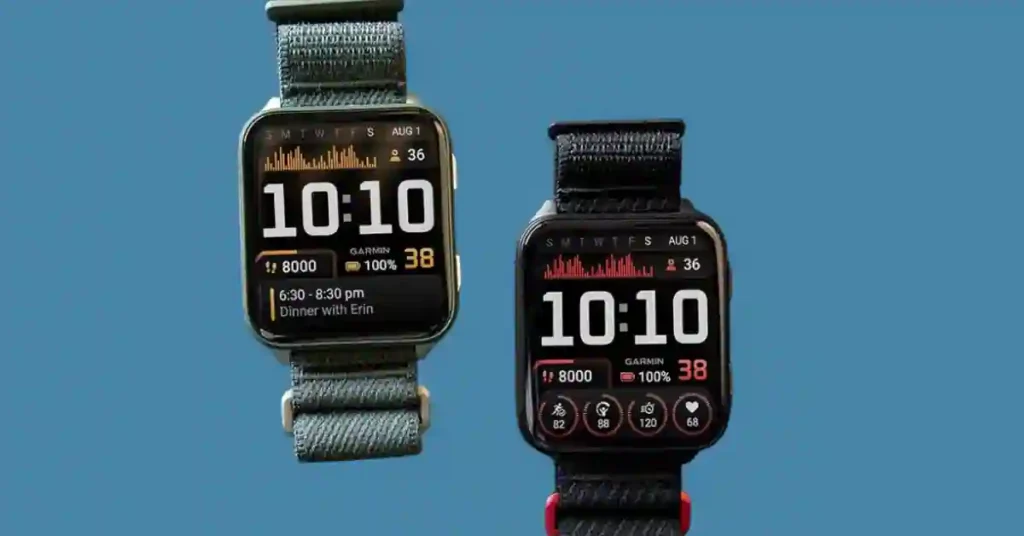
You can enable an Always-On Display, but Garmin estimates battery drops to only about 2 days in AOD mode (vs ~8 days in normal smartwatch mode.
The user interface combines Garmin’s familiar watchOS with touches from its higher-end models. You navigate via touch plus two side buttons (a design borrowed from higher-end Forerunners/Fenix, as opposed to the Venu 3’s one-button style).
Underneath, the software flow is essentially the same as a Forerunner 970/Fenix 8, but with Venu-style icons and widgets. In use, the touchscreen is responsive, and easy to swipe through widgets or data fields.
Importantly, the large screen means more data fields and complications fit on each page, and things like maps and graphs are very readable at a glance. Garmin has kept features like raise-to-wake and usual swipe gestures.
The X1 includes some useful interface goodies: a microphone and speaker allow on-watch calls and voice commands (you can say “start a running activity” or “set a timer for 5 minutes” without your phone).
It also supports Voice Memos and on-device voice prompts (though it’s not as full-featured as Siri or Google Assistant.
Overall, the display/interface experience is premium: huge, sharp, and bright, with Garmin’s proven sports OS and customizable watch faces/apps via Connect IQ.
Garmin Venu X1 Key Features & Specs
Health Metrics
The X1 covers all the usual Garmin health tracking — 24/7 heart rate, pulse oximetry (SpO₂), sleep stages, stress and HRV tracking, Body Battery™ energy estimates, and advanced sleep insights.
It uses Garmin’s Elevate Gen5 optical sensor for heart rate. Notably, ECG capabilities are not included (Garmin confirmed there’s no ECG hardware on this model). (The body Temperature sensor is also absent.)
Fitness Tracking
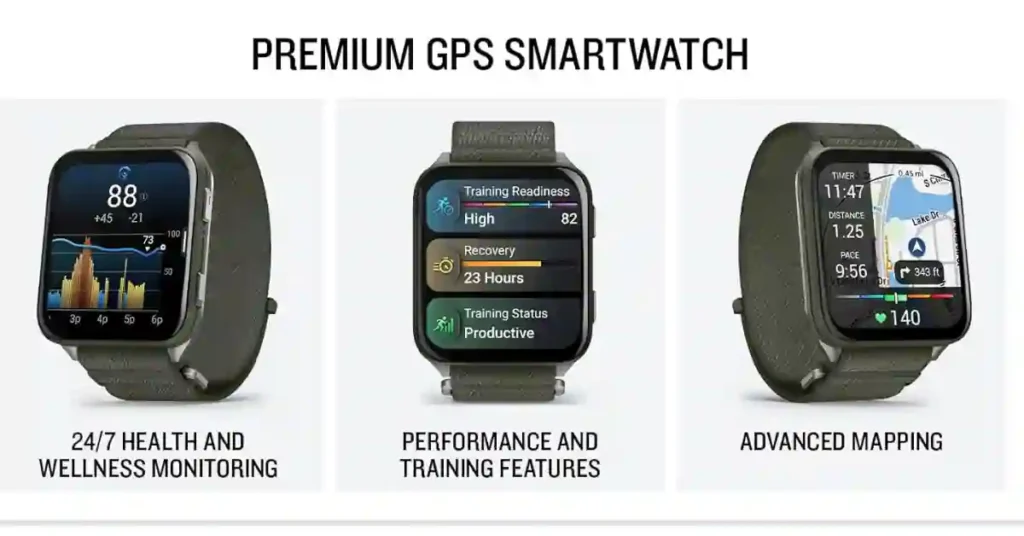
The Venu X1 is essentially a full-fledged sports watch. It has GPS/Glonass/Galileo for accurate tracking (single-frequency GNSS; no dual-band). Over 100 built-in sports profiles are available – everything from running, cycling, swimming, strength, hiking, and golf to various HIIT and gym workouts.
It supports multisport/triathlon modes as well. All the advanced Garmin training features are here: training status and load, training readiness, VO₂ max and performance condition, lactate threshold, real-time stamina, heat and altitude acclimation, and more.
The watch also provides hill/climb scores and endurance scoring for endurance events.
Navigation & Maps
Unusually for a Venu, the X1 includes offline full-color topo Active maps and navigation.
You can load global maps, do round-trip routing, follow courses, re-route, and see ClimbPro climb details right on the watch. This is a big step up from the Venu 3 (which had no maps).
Smartwatch Features
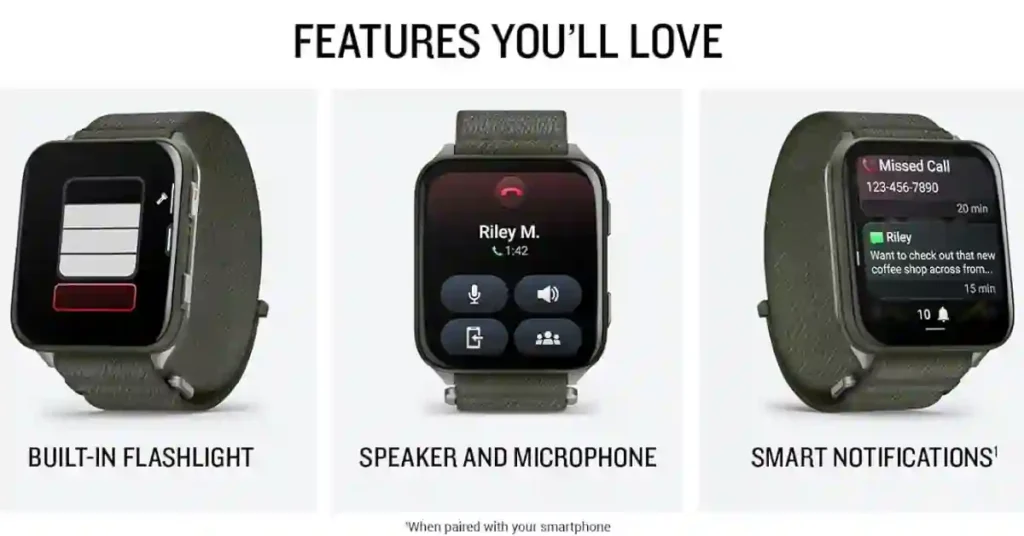
The X1 lets you stay connected. It shows phone notifications and has Bluetooth calling (microphone and speaker built-in) so you can take calls with your phone nearby.
Music can be stored on the watch or streamed from apps (e.g. Spotify) and piped to Bluetooth headphones. Garmin Pay contactless payments are supported.
There’s also a simple voice assistant for certain commands and voice memos on-device.
Battery Life
Garmin rates up to 8 days in smartwatch mode (with standard usage). That drops to around 2 days if you use Always-On Display or heavy GPS.
In practice, reviewers expect similar performance to the Fenix 8 (about a week in normal use). There’s also a battery-saver mode (~11 days) and about 14–16 hours of full GPS use.
Typical charging (via included proprietary cable) is around 1–2 hours for a full charge.
Garmin Venu X1 New & Standout Features
The Venu X1 packs many unique selling points that set it apart from earlier Venues:
Thinnest Garmin Watch: At only 8 mm thick, this is Garmin’s thinnest GPS watch ever. It’s been years since Garmin built something this slim.
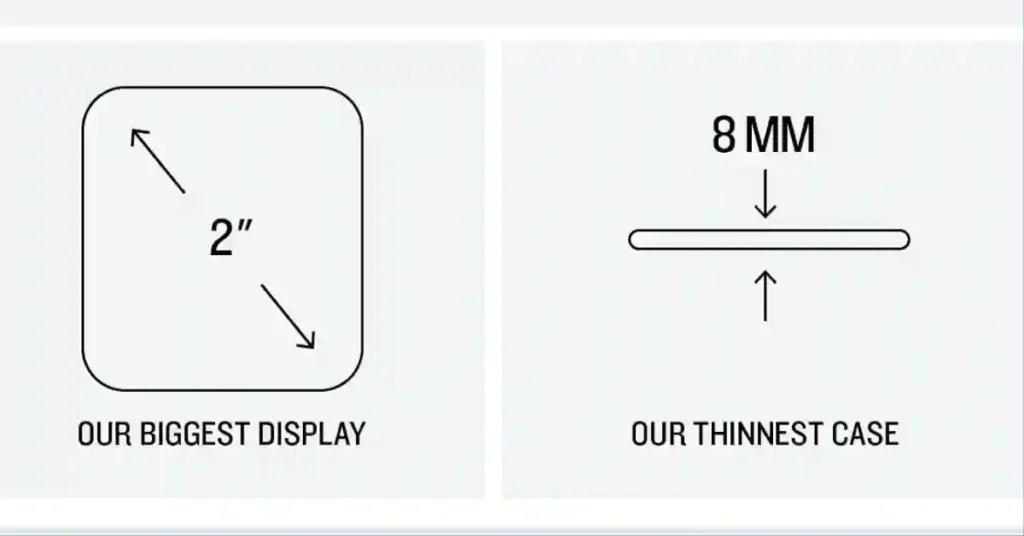
Largest Display: That wall-sized 2″ AMOLED screen is a first for Garmin (bigger than even the Apple Watch Ultra 2’s 1.93″).
Premium Materials: Full titanium case and sapphire glass give it a luxury feel. (Previous Venu models used steel or aluminum.)
Built-In Flashlight: The integrated LED flashlight (white and red) is unheard of on a Garmin fitness watch. It’s handy for running or camping.
Advanced Mapping & Routing: Unlike prior Venu watches, the X1 can download global topo maps and do on-watch navigation and round-trip routing.
Top-Level Training Tools: It “gets almost everything held back from the Venu 3.” Data such as Training Readiness, Training Status, ClimbPro, Strava Live Segments, Race Wizard, Endurance/Hill Scores, and more are now on the X1.
Essentially, most of the Forerunner 970/Fenix 8 feature set is onboard (aside from a few omissions like ECG).
Voice & Audio: The return of microphone + speaker brings on-device voice commands, voice notes, and music playback (also present on watches like the Fenix 8). You can even do a few tasks hands-free via voice.
Unique Style: The squircle form factor and premium band (ComfortFit nylon) give it a unique blend of rugged sportiness and modern style that Garmin hasn’t offered since the very first Vivoactive.
There’s no AI assistant or solar charging here – Garmin stays focused on core fitness features. But the X1’s combination of premium design, giant display, and high-end sports functionality is new for 2025.
Garmin OS & App Integration
Software-wise, the Venu X1 is very much part of Garmin’s established ecosystem.
It runs Garmin’s latest OS (essentially the same as on Fenix/Forerunner) and pairs with the Garmin Connect mobile app for data and customization.
After you pair your phone, the X1 will automatically sync your activities and health stats to Garmin Connect.
Within Connect you can view detailed charts, and weekly summaries, and send data to third-party services (Strava, TrainingPeaks, etc.) just like any Garmin watch.
The X1 also supports the Connect IQ platform: you can download custom watch faces, data fields, and apps from the Garmin Connect IQ store via the mobile app.
For example, you could add new data screens (e.g. camera remote, calculator) or third-party timer apps to the watch.
Garmin Pay is set up through the Connect app, and Garmin Coach training plans or workouts can be synced to it.

In short, if you’ve used Garmin watches before, the X1 will feel very familiar in terms of syncing and software, and it will benefit from Garmin’s regular firmware updates and ConnectIQ ecosystem just like other watches.
In real-world use, the Venu X1 impresses with its comfort and performance.
The extra-large AMOLED screen makes workout stats and maps easy to read at a glance – even in bright sunlight – and reviewers note it is like having “a wall-mounted TV” on the wrist.
Despite its size, it remains feather-light (about 40 g with band), so you’ll hardly notice it during runs or lifting sessions. The UI is fluid and snappy, and the two-button layout plus touchscreen feels intuitive for navigating sports modes.
During exercise, the tracking is on par with Garmin’s best, albeit with single-frequency GPS only. Battery life easily handles a week of workouts plus daily use (Android Central confirms 8 days of regular use).
The optical heart-rate sensor (Garmin’s Elevate Gen5) is just as accurate as on other top Garmin watches, which means reliable HR and pulse-ox readings during steady activities (though, as with any wrist sensor, very high-intensity or rapid movements can occasionally introduce slight errors).
The onboard flashlight and on-watch calls can be surprisingly handy in practical scenarios (e.g. night runs or needing to call out hands-free).
Overall, the Venu X1 feels like a luxury Venu 3 on steroids – it has the softer, two-button style of the Venu line but the guts and polish of a Fenix 8/Forerunner 970.
Early testers described it as “unlike anything Garmin has released in a decade”, bringing Forerunner-grade features to a mainstream audience.
Venu X1 vs Venu 3 / Apple Watch / Samsung Galaxy
Garmin Venu X1 vs Venu 3
The X1 is a major step up. It has a 2″ square AMOLED (vs 1.4″ round on the Venu 3), a titanium case with sapphire glass (instead of aluminum/steel), and is only 8 mm thick (about 4–5 mm thinner).
The X1 adds full offline topo maps and advanced on-watch navigation, whereas the Venu 3 has no maps. Training features like Training Status/Readiness, ClimbPro, Hill Score, and more are on the X1 but absent on the 3.
Battery-wise, the Venu 3 lasts slightly longer (around 9 days normal, 5 AOD) vs 8 days (2 AOD) on the X1.
However, the X1’s ultra-premium build and flashlight/audio make it a far more advanced device. Price: ~ $799 for X1 vs ~ USD 449 for Venu 3.
Garmin Venu X1 vs Apple Watch Series 9
Apple’s Series 9 is a general smartwatch running WatchOS, whereas the X1 is a sport-focused watch. The Series 9 has ECG, cellular options, and a rich app ecosystem, but its battery life is only about 18–36 hours (daily charging) – far less than the ~8 days on the X1.
The X1’s 2″ display is even larger than the Series 9 (the Series 9’s 45mm is ~1.9″ OLED). On the other hand, WatchOS offers deeper smartphone integration and many apps; the X1 relies on Connect IQ for apps.
Garmin’s forte is fitness tracking and battery: it includes VO₂ max, GPS tracking, offline maps, and a week-long charge, whereas the Apple Watch has fewer built-in outdoor fitness features but includes ECG/AFib alerts.
The X1 also has Garmin Pay instead of Apple Pay and supports both iOS and Android phones. Price-wise, the X1 is $799, while an Apple Watch Series 9 (GPS) is around $399–$429.
Garmin Venu X1 vs Samsung Galaxy Watch 6
Samsung’s Watch 6 runs Wear OS and targets Android users. It has a round AMOLED display (~40–45 mm) and about 2 days of battery life. It includes HR, SpO₂, ECG, and (in some regions) blood pressure sensors, but generally has fewer specialized workout analytics than Garmin.
The Galaxy Watch 6 is lighter (~30 g) and thinner (~10 mm), but it can’t match the X1’s ~8-day battery, rugged outdoor features, or built-in GPS accuracy.
The X1 offers advanced sports modes, offline maps, and Garmin’s ecosystem for fitness, whereas Samsung’s watch is stronger on general smart features (Google services, Play Store, etc.) but weaker on endurance metrics. The price for Watch 6 starts around $300–$350.
In summary, the Venu X1 is in a higher league of fitness-focused premium smartwatches. Compared to the Venu 3 it’s a huge upgrade; compared to Apple/Samsung, it offers much better endurance and sports tools at the expense of a smaller app ecosystem.
Pricing & Availability
The Garmin Venu X1 launched at $799.99. At launch (June 18, 2025), it’s offered in two color editions: Black with slate titanium back, and Moss (dark green) with titanium back.
Only a GPS (non-cellular) model is available. Garmin sells it directly on their website and through major retailers worldwide. (As of now, Garmin has not announced any LTE version or special editions beyond the two color options.)
Note: Garmin’s global launch on June 18 means it may take longer to reach some regions. In any case, expect the Venu X1 to be available in North America, Europe, and most major markets by mid-2025.
Who It’s Ideal For: Fitness enthusiasts and Garmin loyalists who want a premium, ultra-thin watch with Garmin’s top fitness features.
If you do lots of trail running, hiking, or multisport activities and appreciate the mapping/navigation tools, the Venu X1 is tempting.
It’s also great if you simply value the large display and long battery in a light package.
Who Might Skip It: Users on a budget or those who don’t need all the advanced metrics might prefer the cheaper Venu 3 or Forerunner 265.
Also, if you want ECG or deeper smartwatch app support, an Apple Watch or Galaxy Watch might be better. Given its price, buyers will have to decide if the X1’s extras (maps, flashlight, titanium) are worth the premium.
In short, the Garmin Venu X1 is a premium fitness watch that carves out its niche. For those who fit its target profile—serious fitness users who crave both style and substance—it’s likely worth the upgrade.
But for casual users, its price and missing features (like ECG) may tip the scales toward a more basic Garmin or competing smartwatch.
FAQs
Is the Garmin Venu X1 waterproof?
Yes – it has a 5 ATM (50-meter) water rating. That means it’s safe for swimming and rain, but Garmin did not equip it for diving or high-pressure water sports. (In comparison, some Garmin Fenix/Forerunner models are 100m rated.) Users note this 50m spec as a design trade-off for the ultra-thin case.
What is the battery life of the Garmin Venu X1?
Garmin claims up to 8 days in normal smartwatch mode, or about 2 days with Always-On Display active. Real-world tests align with that: you can expect roughly a week of typical use (notifications, sleep tracking, 1–2 hours of GPS activity per day). The watch also has a Battery Saver mode (~11 days) and lasts ~14–16 hours in full GPS mode.
How accurate is the Garmin Venu X1’s heart rate sensor?
Venu X1 uses Garmin’s latest Elevate Gen5 optical heart-rate sensor, the same technology found in their flagship models. Garmin does not publish exact accuracy specs, but Elevate Gen5 is generally regarded as one of the more accurate wrist HR sensors on the market. In practice, it should match the performance of other recent Garmin watches (excellent at rest and moderate exercise). As with all optical monitors, accuracy may drop during very high-intensity bursts or if the watch is worn loosely.
Also Read:-
- Garmin Venu 3 Review: Unveiling the Ultimate Smartwatch Experience.
- Garmin Venu 3S Review: Everything You Need to Know.
- Garmin Venu 3 vs Vivoactive 5: Which One is the Best for 2025?.
- Garmin Venu 4 vs. Venu 3: 10 Exciting New Features You Need to Know.
- Venu X1 Firmware 10.63: What Garmin Users Need to Know

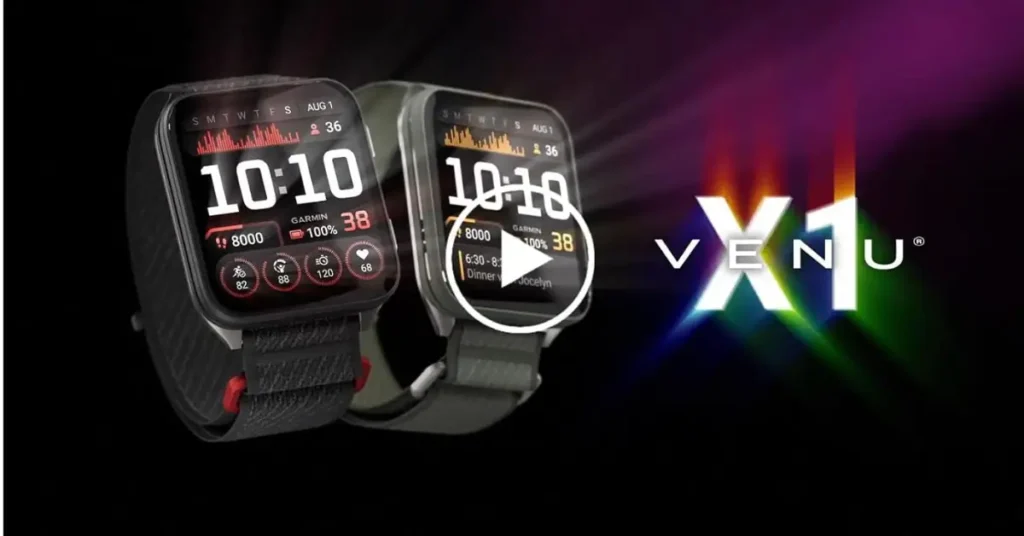

![Garmin Venu X1 Hands-On: Everything You Need to Know! 10 Apple Watch Series 9 [GPS 41mm] Smartwatch with Starlight Aluminu...](https://m.media-amazon.com/images/I/31qIDCkqd5L._SL500_.jpg)
